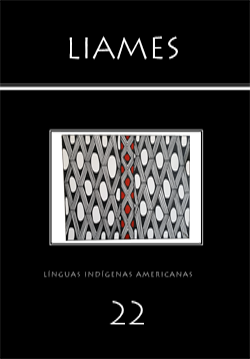Abstract
Causativization is a recurrent phenomenon in languages. It is conceived as a morphosyntactic mechanism that affects both the structure and the functioning of a sentence, with the valency increase being one of the most visible and discussed effects in the literature on causativization. The objective of this work is to discuss how it affects valency in the Asuriní do Xingu, Tupí-Guaraní language, spoken by the Asuriní do Xingu people, who live in the municipality of Altamira, state of Pará. The work starts from the use of different verb types in the basic and derived forms by causativization, verifying the semantics and morphosyntax of the derived sentences, especially those effects directly linked to verbal valency. There are three morphological causatives found in the language: {mu-}, {eru-} and {-ukat}, express different types of causativization and affect the valency of the construction. When they are attached to a verb, they introduce a new participant in the discourse, who assumes the role of CAUSER, giving rise to yet another argument in the sentence: monovalent verbs become bivalent and the latter become trivalent. Thus, the work supports the existence of a close relationship between causativization, transitivity and valency increase in the language.
References
Comrie, Bernard (1989). Causative Constructions. In Language universals and linguistic Typology, pp. 165-184. Chicago: The University of Chicago Press.
Creissels, Denis (2016). Transitivity, valency, and voice. Porquerolles-França: European Summer School in Linguistic Typology. http://www.deniscreissels.fr/public/Creissels-ESSLT.pdf
Fillmore, Charles J. (1976). Algunos problemas de la gramática de casos. En Víctor Sánchez de Zavala. Semántica y sintaxis en la lingüística transformatoria, vol. 2: 171-200. Madrid: Alianza editorial.
Dixon, R.M.W. (2000). A typology of causatives: form, syntax and meaning. In R.M.W. Dixon & Alexandra Y. Aikhenvald (eds.), Changing valency, pp. 30-83. Cambridge: Cambridge University Press.
Dixon, R.M.W.; Aikhenvald, Alexandra Y. (2000). Introduction. In R.M.W. Dixon; Alexandra Aikhenvald Y.(eds.), Changing valency: Case studies in transitivity, pp. 1-29. Cambridge: Cambridge University Press. https://doi.org/10.1017/CBO9780511627750.002
Foley, William; VAN VALIN, Robert Jr. (1984). Functional syntax and universal grammar. Cambridge: Cambridge University Press.
Galúcio, Ana Vilacy (2009). Causativização na língua Mekens. Revista Moara 32: 171-188. http://dx.doi.org/10.18542/moara.v2i32.3650
Haspelmath. Martin; Müller-Bardey, Thomas (1991). Valence change. MPI Leipzig & Universität Mainz. https://www.eva.mpg.de/fileadmin/content_files/staff/haspelmt/pdf/2005val.pdf
Kemmer, Suzanne; Verhagen, Arie (1994). The grammar of causatives and the conceptual structure of events. Cognitive Linguistics 5(2): 115-156. https://doi.org/10.1515/cogl.1994.5.2.115
Kulikov, Leonid (2010). Voice typology. In Jae Jung Song (ed.), The Oxford handbook of linguistic typology, pp. 368-398. Oxford: Oxford University Press.
Leite, Yonne (1994). As construções causativas em Tapirapé. Revista Latinoamericana de Estudios Etnolingüísticos 3: 73-86.
Pereira, Antônia Alves (2009). Estudo morfossintático do Asuriní do Xingu (Tese doutorado em linguística). Campinas, SP.: Universidade Estadual de Campinas. https://hdl.handle.net/20.500.12733/1609402
Pereira, Antônia Alves (2015). Aspectos da hierarquia de pessoa em Asuriní do Xingu. Revista Educação e Linguagens 4(6): 97-106. https://periodicos.unespar.edu.br/index.php/revistaeduclings/article/view/6396
Pereira, Antônia Alves (2021). Marcação de caso e funções sintáticas em Asuriní do Xingu. Revista Moara 58: 79-102. http://dx.doi.org/10.18542/moara.v0i58.10851
Pereira, Antônia Alves (2022). Causativização em Asuriní do Xingu. Ms. submetido à publicação.
Rose, Françoise (2003). Morphosyntaxe de l'emerillon. Une language tupí-guaraní de Guyane Française (Tese Doutorado). França, Université Lumière Lyon 2. https://tel.archives-ouvertes.fr/tel-00452100
Seki, Lucy (2000). Gramática do Kamaiurá: Língua Tupi-Guarani do Alto Xingu. Campinas: Editora da UNICAMP.
Shibatani, Masayoshi (ed.) (2002). The grammar of causation and interpersonal Manipulation [Typological Studies in Language48]. Amsterdam: John Benjamins. https://doi.org/10.1075/tsl.48
Shibatani, Masayoshi; Pardeshi, Prashant (2002). The causative continuum. In Masayoshi Shibatani (ed), The grammar of causation and interpersonal Manipulation [Typological Studies in Language 48], pp. 85-126. Amsterdam: John Benjamins. https://doi.org/10.1075/tsl.48.07shi
Song, Jae Jung (2014). Linguistic typology: Morphology and syntax. New York: Routledge,
Talmy, Leonard (2007). Lexical typologies. In Thimothy Shopen (ed.), Language typology and syntactic description. 2nd.edn., vol. 3. Grammatical categories and the lexicon, pp. 66-168. Cambridge: Cambridge University Press.
Velupillai, Viveka (2012). An introduction to linguistic typology. Amsterdam, Philadelphia: John Benjamins Publishing Company.

This work is licensed under a Creative Commons Attribution-NonCommercial 4.0 International License.
Copyright (c) 2022 Antonia Alves Pereira


